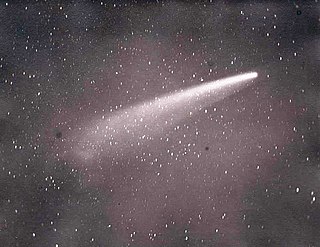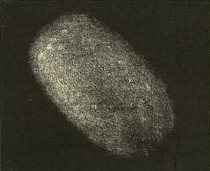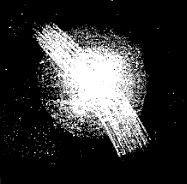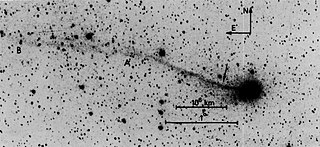Related Research Articles

A meteor shower is a celestial event in which a number of meteors are observed to radiate, or originate, from one point in the night sky. These meteors are caused by streams of cosmic debris called meteoroids entering Earth's atmosphere at extremely high speeds on parallel trajectories. Most meteors are smaller than a grain of sand, so almost all of them disintegrate and never hit the Earth's surface. Very intense or unusual meteor showers are known as meteor outbursts and meteor storms, which produce at least 1,000 meteors an hour, most notably from the Leonids. The Meteor Data Centre lists over 900 suspected meteor showers of which about 100 are well established. Several organizations point to viewing opportunities on the Internet. NASA maintains a daily map of active meteor showers.
The Quadrantids (QUA) are a meteor shower that peaks in early January and whose radiant lies in the constellation Boötes. The zenithal hourly rate (ZHR) of this shower can be as high as that of two other reliably rich meteor showers, the Perseids in August and the Geminids in December, yet Quadrantid meteors are not seen as often as those of the two other showers because the time frame of the peak is exceedingly narrow, sometimes lasting only hours. Moreover, the meteors are quite faint, with mean apparent magnitudes between 3.0 and 6.0.

The Great Comet of 1882, formally designated as C/1882 R1, 1882 II, and 1882b, was a comet which became very bright in September 1882. It was a member of the Kreutz Sungrazers, a family of comets which pass within 1 R☉ of the Sun's photosphere at perihelion.

5D/Brorsen was a periodic Jupiter-family comet discovered on February 26, 1846, by Danish astronomer Theodor Brorsen. The comet was last seen in 1879 and is now considered lost.
C/2007 W1 (Boattini) is a non-periodic comet discovered on 20 November 2007, by Andrea Boattini at the Mt. Lemmon Survey. At the peak the comet had an apparent magnitude around 5.
(5496) 1973 NA, is a very eccentric and heavily tilted asteroid, classified as near-Earth object of the Apollo group, approximately 2 kilometers in diameter. It was discovered on 4 July 1973, by American astronomer Eleanor Helin at the U.S. Palomar Observatory in California. At the time of its discovery, it was the most highly inclined minor planet known to exist. It may be the parent body of the Quadrantids.

The Great Comet of 1823, also designated C/1823 Y1 or Comet De Bréauté-Pons, was a bright comet visible from December 1823 to April 1824.

(196256) 2003 EH1 is an asteroid, classified as near-Earth object of the Amor group. It was discovered on 6 March 2003, by astronomers of the LONEOS program at Anderson Mesa Station near Flagstaff, Arizona, in the United States. Peter Jenniskens (2003–2004) proposed that it is the parent body of the Quadrantid meteor shower. 2003 EH1 is likely an extinct comet and may even be related to the comet C/1490 Y1. 2003 EH1 came to perihelion on 12 March 2014.

Comet Swift–Tuttle is a large periodic comet with a 1995 (osculating) orbital period of 133 years that is in a 1:11 orbital resonance with Jupiter. It fits the classical definition of a Halley-type comet, which has an orbital period between 20 and 200 years. The comet was independently discovered by Lewis Swift on 16 July 1862 and by Horace Parnell Tuttle on 19 July 1862.
The Qingyang event was a presumed meteor shower or air burst that took place near Qingyang in March or April 1490. The area was at the time part of Shaanxi, but is now in Gansu province. A 1994 study in the journal Meteoritics tentatively explained this event as a meteor air burst.
Comet Latyshev–Wild–Burnham, also known as C/1957 U1, is a faint parabolic comet that was observed during the third week of October 1957. It was the first comet discovered by American astronomer Robert Burnham, Jr., which he co-discovered alongside Turkmen astronomer, Ivan N. Latyshev, and Swiss astronomer, Paul Wild.

249P/LINEAR is a periodic Jupiter-family comet with an orbital period of 4.61 years. It was discovered by LINEAR on 19 October 2006. It is only active for a brief period around perihelion.

C/1979 Y1 (Bradfield), also known as Comet 1979X and 1979l, is a long period comet discovered by William A. Bradfield on 24 December 1979. The comet has an orbital period of 308 ± 6 years and last passed perihelion on 21 December 1979. It is considered to be the parent body of the July Pegasids meteor shower. It is expected to next come to perihelion around 2287.
C/1917 F1 (Mellish), also known as Comet 1917Ι and 1917a, is a Halley-type comet discovered by John E. Mellish on 19 March 1917. The comet has an orbital period of 143 years and last passed perihelion on 11 April 1917. It is the parent body of the December Monocerotids and has also been suggested to be the parent body of daytime kappa Leonids, April ρ-Cygnids, November Orionids, and Canis-Minorids meteor showers.
Comet Ikeya-Seki, formally designated as C/1967 Y1, is a retrograde non-periodic comet discovered by Kaoru Ikeya and Tsutomu Seki on 1967. It is the second comet discovered together by the two Japanese astronomers after C/1965 S1.

C/1911 N1 (Kiess) is a non-periodic comet discovered by Carl Clarence Kiess on 6 July 1911. The comet has been identified as the parent body of the Aurigids meteor shower.
C/1983 J1 (Sugano–Saigusa–Fujikawa) is a non-periodic comet discovered by Matsuo Sugano, Yoshikazu Saigusa, and Shigehisa Fujikawa on 8 May 1983. The comet approached Earth at a distance of 0.063 AU on 12 June 1983.

Comet Borrelly–Brooks, formal designation C/1900 O1, is a hyperbolic comet that was seen throughout the latter half of 1900.
The Great Comet of 390 AD, also known as C/390 Q1 by its modern designation, was a comet that appeared very bright in the night sky. It was recorded prominently in ancient Chinese and Korean texts, particularly the Chén Shū.
Barnard's Comet, formally designated as C/1891 T1, is a faint non-periodic comet that was observed through telescopes in late 1891. It is one of 16 comets discovered by Edward Emerson Barnard.
References
- 1 2 3 G. W. Kronk; M. Meyer; D. A. J. Seargent (1999). Cometography: A Catalog of Comets. Vol. 1: Ancient–1799. Cambridge University Press. pp. 290–291. ISBN 978-0-521-58504-0.
- ↑ "Comet Names and Designations". International Comet Quarterly. Retrieved 21 January 2025.
- ↑ "C/1490 Y1 – JPL Small-Body Database Lookup". ssd.jpl.nasa.gov. Jet Propulsion Laboratory . Retrieved 14 November 2024.
- ↑ K. W. Lee; H. J. Yang; M. G. Park (2009). "Orbital Elements of Comet C/1490 Y1 and the Quadrantid Shower" (PDF). Monthly Notices of the Royal Astronomical Society. 400 (3): 1389–1393. arXiv: 0908.2547 . Bibcode:2009MNRAS.400.1389L. doi: 10.1111/j.1365-2966.2009.15535.x .
- ↑ J. R. Hind (1846). "Schreiben des Herrn J. R. Hind an den Herausgeber". Astronomische Nachrichten (in German). 23 (25): 377–378. Bibcode:1846AN.....23..377H. doi:10.1002/asna.18460232502.
- ↑ I. Hasegawa. "Orbits of Ancient and Medieval Comets". Publications of the Astronomical Society of Japan. 31: 257–270. Bibcode:1979PASJ...31..257H.

